Résultats de recherche de titre
Articles 1497181 à 1497200 sur 1497347
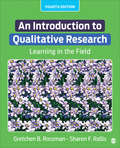
An Introduction to Qualitative Research: Learning in the Field
Par Sharon F Rallis, Gretchen B Rossman. 2017
The updated Fourth Edition of Rossman and Rallis’s popular introductory text leads the new researcher into the field by explaining…
the core concepts through theory, research, and applied examples. Woven into the chapters are three themes that are the heart of the book: first, research is about learning; second, research can and should be useful; and finally, a researcher should practice the highest ethical standards to ensure that a study is trustworthy. The Fourth Edition includes an elaborate discussion of systematic inquiry as well as a nuanced discussion of developing a conceptual framework.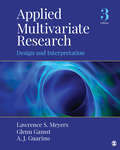
Applied Multivariate Research: Design and Interpretation
Par Lawrence S. Meyers, Glenn C. Gamst, Anthony J. Guarino. 2017
Using a conceptual, non-mathematical approach, the updated Third Edition provides full coverage of the wide range of multivariate topics that…
graduate students across the social and behavioral sciences encounter. Authors Lawrence S. Meyers, Glenn Gamst, and A. J. Guarino integrate innovative multicultural topics in examples throughout the book, which include both conceptual and practical coverage of: statistical techniques of data screening; multiple regression; multilevel modeling; exploratory factor analysis; discriminant analysis; structural equation modeling; structural equation modeling invariance; survival analysis; multidimensional scaling; and cluster analysis.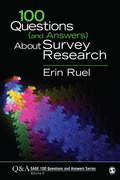
100 Questions (SAGE 100 Questions and Answers #6)
Par Erin Ruel. 2019
Erin Ruel′s 100 Questions (and Answers) About Survey Research covers the entire survey research process, starting with developing research questions…
and ending with the analysis and write-up. It includes the traditional survey topics of design, sampling, question writing, and validity; includes a chapter on research ethics; covers the important topics of preparing, cleaning, and analyzing data; and ends with a section on how to write up survey results for a variety of purposes. Useful as a supplementary text in the classroom or as a reference guide for anyone starting a new survey project, the guidance is presented in a FAQ style to allow readers to jump around the book, so as to accommodate the nonlinear and iterative nature of research.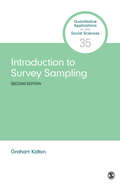
Introduction to Survey Sampling (Quantitative Applications in the Social Sciences #35)
Par Graham Kalton. 2021
Sample design is key to all surveys, fundamental to data collection, and to the analysis and interpretation of the data.…
Introduction to Survey Sampling, Second Edition provides an authoritative and accessible source on sample design strategies and procedures that is a required reading for anyone collecting or analyzing survey data. Graham Kalton discusses different types of probability samples, stratification (pre and post), clustering, dual frames, replicates, response, base weights, design effects, and effective sample size. It is a thorough revision and update of the first edition, published more than 35 years ago. Although the concepts of probability sampling are largely the same, there have been important developments in the application of these concepts as research questions have increasingly spanned multiple disciplines, computers have become central to data collection as well as data analysis, and cell phones have become ubiquitous, but response rates have fallen, and public willingness to engage in survey research has waned. While most of the volume focuses on probability samples, there is also a chapter on nonprobability samples, which are becoming increasingly important with the rise of social media and the world wide web.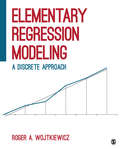
Elementary Regression Modeling: A Discrete Approach
Par Roger A. Wojtkiewicz. 2017
Elementary Regression Modeling builds on simple differences between groups to explain regression and regression modeling. User-friendly and immediately accessible, this…
book gives readers a thorough understanding of control modeling, interaction modeling, modeling linearity with spline variables, and creating research hypotheses that serve as a conceptual basis for many of the processes and procedures quantitative researchers follow when conducting regression analyses.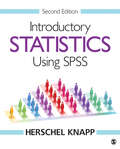
Introductory Statistics Using SPSS
Par Herschel Knapp. 2017
The updated Second Edition of Herschel Knapp’s friendly and practical introduction to statistics shows students how to properly select, process,…
and interpret statistics without heavy emphasis on theory, formula derivations, or abstract mathematical concepts. Each chapter is structured to answer questions that students most want answered: What statistical test should I use for this situation? How do I set up the data? How do I run the test? How do I interpret and document the results? Online tutorial videos, examples, screenshots, and intuitive illustrations help students "get the story" from their data as they learn by doing, completing practice exercises at the end of each chapter using prepared downloadable data sets.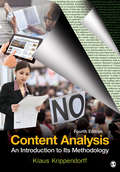
Content Analysis: An Introduction to Its Methodology
Par Klaus Krippendorff. 2019
What matters in people’s social lives? What motivates and inspires our society? How do we enact what we know? Since…
the first edition published in 1980, Content Analysis has helped shape and define the field. In the highly anticipated Fourth Edition, award-winning scholar and author Klaus Krippendorff introduces readers to the most current method of analyzing the textual fabric of contemporary society. Students and scholars will learn to treat data not as physical events but as communications that are created and disseminated to be seen, read, interpreted, enacted, and reflected upon according to the meanings they have for their recipients. Interpreting communications as texts in the contexts of their social uses distinguishes content analysis from other empirical methods of inquiry. Organized into three parts, Content Analysis first examines the conceptual aspects of content analysis, then discusses components such as unitizing and sampling, and concludes by showing readers how to trace the analytical paths and apply evaluative techniques. The Fourth Edition has been completely revised to offer readers the most current techniques and research on content analysis, including new information on reliability and social media. Readers will also gain practical advice and experience for teaching academic and commercial researchers how to conduct content analysis.
100 Questions (SAGE 100 Questions and Answers #6)
Par Erin Ruel. 2019
Erin Ruel′s 100 Questions (and Answers) About Survey Research covers the entire survey research process, starting with developing research questions…
and ending with the analysis and write-up. It includes the traditional survey topics of design, sampling, question writing, and validity; includes a chapter on research ethics; covers the important topics of preparing, cleaning, and analyzing data; and ends with a section on how to write up survey results for a variety of purposes. Useful as a supplementary text in the classroom or as a reference guide for anyone starting a new survey project, the guidance is presented in a FAQ style to allow readers to jump around the book, so as to accommodate the nonlinear and iterative nature of research.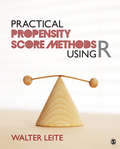
Practical Propensity Score Methods Using R
Par Walter L. Leite. 2017
This practical book uses a step-by-step analysis of realistic examples to help students understand the theory and code for implementing…
propensity score analysis with the R statistical language. With a comparison of both well-established and cutting-edge propensity score methods, the text highlights where solid guidelines exist to support best practices and where there is scarcity of research. Readers will find that this scaffolded approach to R and the book’s free online resources help them apply the text’s concepts to the analysis of their own data.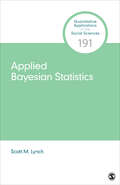
Applied Bayesian Statistics (Quantitative Applications in the Social Sciences)
Par Scott M. Lynch. 2023
Bayesian statistical analyses have become increasingly common over the last two decades. The rapid increase in computing power that facilitated…
their implementation coincided with major changes in the research interests of, and data availability for, social scientists. Specifically, the last two decades have seen an increase in the availability of panel data sets, other hierarchically structured data sets including spatially organized data, along with interests in life course processes and the influence of context on individual behavior and outcomes. The Bayesian approach to statistics is well-suited for these types of data and research questions. Applied Bayesian Statistics is an introduction to these methods that is geared toward social scientists. Author Scott M. Lynch makes the material accessible by emphasizing application more than theory, explaining the math in a step-by-step fashion, and demonstrating the Bayesian approach in analyses of U.S. political trends drawing on data from the General Social Survey.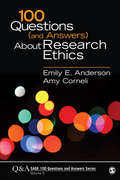
100 Questions (SAGE 100 Questions and Answers #5)
Par Emily E. Anderson, Amy L. Corneli. 2018
100 Questions (and Answers) About Research Ethics is an essential guide for graduate students and researchers in the social and…
behavioral sciences. It identifies ethical issues that individuals must consider when planning research studies as well as provides guidance on how to address ethical issues that might arise during research implementation. Questions such as assessing risks, to protecting privacy and vulnerable populations, obtaining informed consent, using technology including social media, negotiating the IRB process, and handling data ethically are covered. Acting as a resource for students developing their thesis and dissertation proposals and for junior faculty designing research, this book reflects the latest U.S. federal research regulations to take effect mostly in January 2018.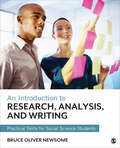
An Introduction to Research, Analysis, and Writing: Practical Skills for Social Science Students
Par Bruce Oliver Newsome. 2016
This accessible guide walks readers through the process of completing a social science research project. Written specifically to meet the…
needs of undergraduate research classes, it introduces students to a complete skill set, including: planning, design, analysis, argumentation, criticizing theories, building theories, modeling theories, choosing methods, gathering data, presenting evidence, and writing the final product. Students can use this text as a practical resource to navigate through each stage of the process, including choices between more advanced research techniques.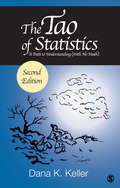
The Tao of Statistics: A Path to Understanding (With No Math)
Par Dana K. Keller. 2016
This Second Edition of The Tao of Statistics: A Path to Understanding (With No Math) provides a reader-friendly approach to…
statistics in plain English. Unlike other statistics books, this text explains what statistics mean and how they are used, rather than how to calculate them. The book walks readers through basic concepts as well as some of the most complex statistical models in use. The Second Edition adds coverage of big data to better address its impact on p-values and other key concepts; material on small data to show readers how to handle data with fewer data points than optimal; and other new topics like missing data and effect sizes. The book’s two characters (a high school principal and a director of public health) return in the revised edition, with their examples expanded and updated with reference to contemporary concerns in the fields of education and health.
Practical Propensity Score Methods Using R
Par Walter L. Leite. 2017
This practical book uses a step-by-step analysis of realistic examples to help students understand the theory and code for implementing…
propensity score analysis with the R statistical language. With a comparison of both well-established and cutting-edge propensity score methods, the text highlights where solid guidelines exist to support best practices and where there is scarcity of research. Readers will find that this scaffolded approach to R and the book’s free online resources help them apply the text’s concepts to the analysis of their own data.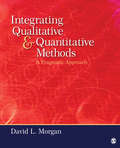
Integrating Qualitative and Quantitative Methods: A Pragmatic Approach
Par David L. Morgan. 2014
Focusing on research designs for projects that collect both qualitative and quantitative data, this practical book discusses strategies for bringing…
qualitative and quantitative methods together so that their combined strengths accomplish more than is possible with a single method. The approach is broadly interdisciplinary, reflecting the interest in mixed methods research of social scientists from anthropology, communication, criminal justice, education, evaluation, nursing, organizational behavior, psychology, political science, public administration, public health, sociology, social work, and urban studies. In contrast to an "anything goes" approach or a naïve hope that "two methods are better than one," the author argues that projects using mixed methods must pay even more attention to research design than single method approaches. The book’s practical emphasis on mixed methods makes it useful both to active researchers and to students who intend to pursue such a career.
Applied Multivariate Research: Design and Interpretation
Par Lawrence S. Meyers, Glenn C. Gamst, Anthony J. Guarino. 2017
Using a conceptual, non-mathematical approach, the updated Third Edition provides full coverage of the wide range of multivariate topics that…
graduate students across the social and behavioral sciences encounter. Authors Lawrence S. Meyers, Glenn Gamst, and A. J. Guarino integrate innovative multicultural topics in examples throughout the book, which include both conceptual and practical coverage of: statistical techniques of data screening; multiple regression; multilevel modeling; exploratory factor analysis; discriminant analysis; structural equation modeling; structural equation modeling invariance; survival analysis; multidimensional scaling; and cluster analysis.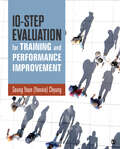
10-Step Evaluation for Training and Performance Improvement
Par Seung Youn Chyung. 2019
Written with a learning-by-doing approach in mind, 10-Step Evaluation for Training and Performance Improvement gives students actionable instruction for identifying,…
planning, and implementing a client-based program evaluation. The book introduces readers to multiple evaluation frameworks and uses problem-based learning to guide them through a 10-step evaluation process. As students read the chapters, they produce specific deliverables that culminate in a completed evaluation project.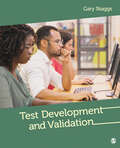
Test Development and Validation
Par Gary Edward Skaggs. 2023
Test Development and Validation by Gary Skaggs summarizes the latest test theories, frameworks for test development and validation, and guidance…
for developing tests in straightforward language in one core text. Students looking for clear, concise explanations of measurement, validity, and test development within a real-world context and with numerous examples will find this book to be an excellent learning resource. Author Gary Skaggs takes years of experience teaching test development to graduate students across social and behavioral sciences and consulting on a wide variety of government and institutional research projects to offer students a thorough, jargon-free, and highly applied book to help propel their own research and careers. Part I of the book, The Big Picture, sets the stage for test development, placing it within the larger context and history of measurement, emphasizing measurement concepts and their evolution over time. Part II, Test Development, covers the technical details of instrument and test development in logical order. Validation, Part III, links the conceptual bases provided in Part I with the technical process provided in Part II to conclude the book. For those students wanting to go further, software suggestions are referenced in the technical chapters, while Further Reading sections offer the original sources for more details. Exercises and Activities at the end of each chapter provide students a variety of ways to apply their knowledge, from conceptual questions to brief project ideas to data analysis problems.
Introduction to Cognitive Ethnography and Systematic Field Work (Qualitative Research Methods)
Par G. Mark Schoepfle. 2022
Introduction to Cognitive Ethnography and Systematic Field Work by G. Mark Schoepfle provides a guide to the fundamentals of cognitive ethnography…
for qualitative research. A focus of this technique is collecting data from flexible but rigorous interviews. These interviews are flexible because they are designed to be structured around the semantic knowledge being elicited from the speaker, not around some pre-conceived design that is based on the researcher’s background, and they are rigorous because the basic linguistic and semantic structures are shared among all cultures. Written by one of the founders of this technique, this text provides a wealth of concentrated knowledge developed over years to best suit this collaborative and participant-centric research process. Eight chapters show how intertwined data collection and analysis are in this method. The first chapter offers a brief history and overview of the cognitive ethnography. Chapter 2 covers planning a research project, from developing a research question to ethics and IRB requirements. The next two chapters cover interview background, techniques, and structures. Chapter 5 addresses analysis while Chapter 6 covers transcription and translation. Chapter 7 covers observation, while a final chapter address writing a report for both consultants and outside audiences.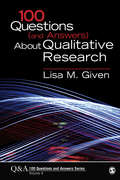
100 Questions (SAGE 100 Questions and Answers)
Par Lisa M. Given. 2016
Exploring 100 key questions (and answers) on the nature and practice of qualitative inquiry, this unique book addresses the practical…
decisions that researchers must make in their work, from the design of the study, through ethics approval, implementation, and writing. The book’s quick-scan, question-and-answer format make it ideal as a supplementary text or as a ready reference for graduate students preparing for comprehensive exams and writing research proposals, undergraduates in affiliated programs who will not be taking a primary course in qualitative research methods, and researchers working across disciplines in academic or practice environments.